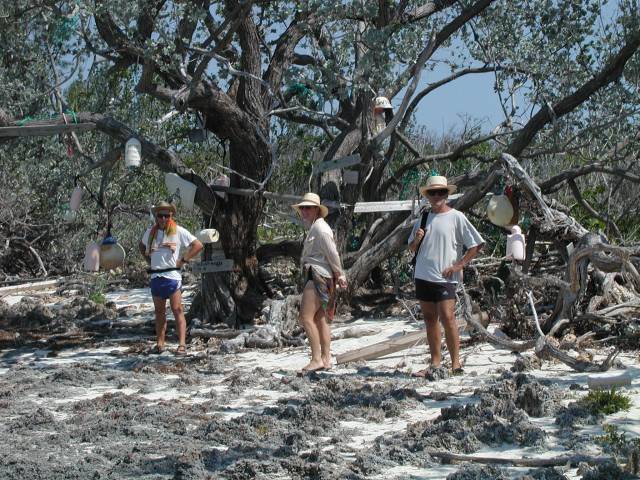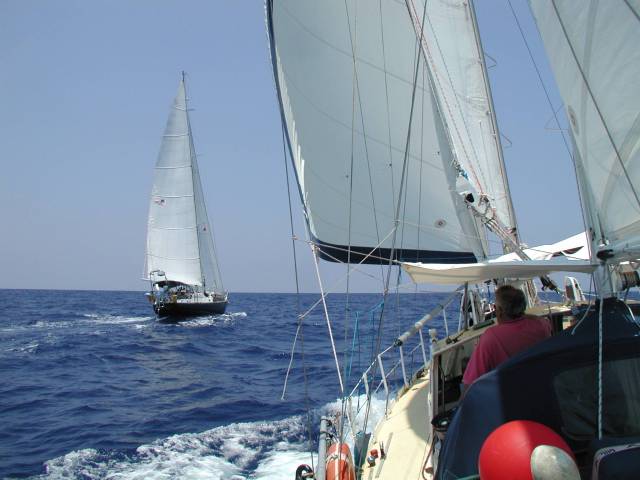|
Abacos, Bahamas 26th
April - 11th May 2005 |
|
Maybe we were out of practice or perhaps our
fifty mile trip to the Abacos, the Bahamas' most northern islands, really
was pretty uncomfortable and rolly. In any case, we were glad to
arrive in Little Harbour and stop rocking. Unfortunately this
phenomenon was short lived and we spent an uncomfortable night at anchor
when the swell picked up again.
Next day we pushed on quickly to Marsh
Harbour, the Abacos' main yachting centre, regretting that we didn't have
the right weather to enjoy snorkeling the reefs on the way.
Later the weather even caused us to just pull over and drop the hook
wherever we were at the time, as the lightning hits came closer and
closer to poor Anju and in torrential rain, visibility was down to
zero. We were lucky to avoid a lightning strike as the
storm raged around us. It was a pity our water-collection awning
wasn't set up while we were sailing as we could have filled our water tanks
many times over in half an hour.
|
|
Greatly relieved we anchored a couple of hours
later in Marsh Harbour with a whole 20 centimetres below our keel at low
water. Our neighbours on Troubadour were observing us
closely with their binoculars, we wondered why but were so happy to arrive
that we weren't bothered. Shortly afterwards came a call on the
VHF from Troubadour welcoming a fellow Welshman to the anchorage, that was
how we met David and his Canadian wife Kate, who quickly became good
friends.
Together we poured over the charts of the
area around Hopetown on a nearby Cay and jointly decided it would be much
less stressful for people with boats with drafts of six feet to take the
ferry there instead! Of course there was a little back-seat navigating
on the way there!
|

Troubadour anchored nearby at sunset in
Marsh Harbour
|

Back seat navigators Kate,
David and Phil on the ferry to Hopetown
|
On arrival in Hopetown we wandered through
the twee streets, mostly made up of holiday homes. We
decided to walk to the town's main landmark, the lighthouse.
After strolling a couple of miles we realised that the lighthouse seemed to
be getting further away and decided it was finally time to ask for
directions. We flagged down a passing golf cart, the islands
preferred method of travel. We were told by the driver that it wasn't
possible to walk to the lighthouse, you had to get there by boat.
Unfortunately we'd left ours in Marsh Harbour! We struck lucky however
and the driver not only gave us a lift back to town, he also gave us a lift
to the lighthouse in his boat! It was well worth the effort of
getting there and we climbed the steps to the top to admire the
view. Then we just had to persuade someone to give us a lift
back again.
|
|
Back in Marsh Harbour, the crews of Anju and
Troubadour shared the experience of staying up all night worrying about
their boats being hit by a menacing Norwegian boat, during a 180 degree wind
shift. When the Norwegian boat had arrived in the
anchorage earlier, we'd all felt he anchored a little close between our two
boats, but weren't unduly worried as anchoring etiquette dictated that if
there was a problem, he'd be the one to re-anchor. However as we
shone spotlights on his boat and used our foghorns to rouse the captain from
his deep slumber at 3 am, to alert the him to the fact that his boat was
about to hit first Troubadour and later Anju, he informed us that his
hydraulic steering cylinder was ashore for service, leaving him without
steering and the ability to move to re-anchor. "It is a bad
situation", he told us. "Too right", we thought,
especially for the crew of Anju, who were forced to take up their anchor in
the pitch dark and pouring rain and try to find a spot further
away. Not only had he anchored thoughtlessly when he knew
his boat would be disabled but he also wasn't displaying an anchor light at
night to help us avoid crashing into his boat as we motored around the
anchorage in our search for a safer spot.
|
|

David and Kate climbing the
lighthouse - pink paint must have been on special offer in Hopetown!
|

We even managed to get Phil
to come outside at the top, to admire the view.
|
|
We decided it was time to leave crowded Marsh
Harbour and headed to Man-O-War Cay in search of peace.
Unfortunately the holding in the anchorage there was poor. We were
worried about our anchor which was barely hooked into the sea bed and
Troubadour couldn't get their anchor to hold at all. Finally we all
decided to head further north to the next Cay, Great Guana Cay,
instead. Troubadour left first as their anchor was already
raised.
As we made our way out of the anchorage, we
managed to find an uncharted underwater rock with Anju's keel.
The boat heeled over alarmingly as we passed by whatever we'd hit and for
several frantic minutes we rushed around checking our bilges for any water
ingress.
|

Searching for treasure on
Great Guana's Atlantic beach.
|
|
Finding nothing amiss, we hurried to the next
anchorage and Phil braved the cold water, thick with brown weed, to check
for damage below the water. When he surfaced again, having
found only a scrape mark along one side of the hull, we were grateful for
Anju's sturdy steel construction.
We spent the next morning beach-coming and on
returning to our boats, found we'd been joined in the anchorage by Pat and
Liz on Catspaw. Later we all enjoyed a "pot luck" dinner
together.
Our next stop was at Green Turtle Cay, to
visit the attractive but hurricane ravaged town and pick up some very pricey
diesel, ready for the trip back to the States.
|

Converting treasure to junk
aboard Anju.
|
|
At Allens-Pensacola Cay, Christine was able to
clean Anju's bottom in the clear water. We were going to need
all the help we could get to keep up with Troubadour! Later we
went in search of the ruins advertised on the chart but failed to find
them. Instead we came across a stack of mementos left by
previous cruisers.
|
|

The cruisers' gallery on
Allens-Pensacola Cay
|

"Hey, wait for us
Troubadour"
|
|
Our final Bahamas destination was another
hurricane ravaged town on Grand Cay and then it was time to set sail for the
United States.
|







